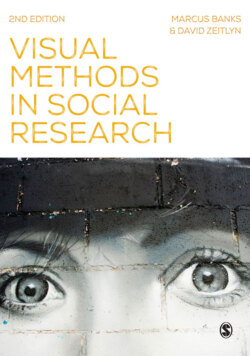Читать книгу Visual Methods in Social Research - Marcus Banks - Страница 7
На сайте Литреса книга снята с продажи.
Preface to the Second Edition
ОглавлениеThis book aims to provide a concise account of some of the ways in which social scientists can incorporate visual images (of various kinds) into their research, together with a discussion of why they might wish to. Images may be the subject of research, (i.e. the material being analyzed) or may play a role as part of the process of analysis (or both). The emphasis is very much on the use of visual materials as one among several research methods that may be employed by a social researcher during the course of an investigation, rather than a focus on the visual for its own sake. We assume that readers already have or are acquiring the skills to devise a research project that is valid within the context of their discipline, but may not have thought of adding a visual dimension (see also below). Those who are already experienced visual researchers and are seeking to add a sociological dimension to their work should probably look elsewhere, as they will probably find what we have to say rather basic with regard to the visual.
While intended as a simple and practical guide for students, academic and non-academic researchers new to the fields of visual anthropology and visual sociology, this is not a technical guide or a style manual for image production. For that, readers should consult the technical manuals readily available in any large bookshop, in conjunction with a more specialist text written by and for social scientists. For film and video, Ilisa Barbash and Lucien Taylor’s Cross-Cultural Filmmaking (1997) is both encyclopaedic in its detail and authoritative in its commentary. For still photography, Terence Wright’s The Photography Handbook (1999) is a relatively short but practical text, shot through with historical, psychological and anthropological insight (Wright was a professional photographer before becoming an academic). For digital media, there is no comparable text to Barbash and Taylor’s or Wright’s books, but we reference the few articles and other sources we have found useful where appropriate.
For this second edition, the original author (MB) invited friend and colleague David Zeitlyn (DZ) to join him in revising the manuscript, as a result of many stimulating discussions we have had over the years. Although occasionally we differentiate ourselves by our initials in what follows, this second edition is genuinely a joint venture: we have revised the entire book, from this Preface to the final chapter, line by line, updating, amending, correcting and rethinking. More significantly, we have added a number of new sections and updated many of the references and examples. New or significantly revised sections include: (i) preparing for a research project with a visual component (Section 1.5); (ii) data visualization (Section 2.3.1); (iii) network analysis (Section 2.3.2); and (iv) copyright and image ethics (Section 5.6).
We are both social anthropologists, one with research interests in India (MB) and the other with research interests in Africa (DZ); but we have tried to write this book to be of interest and relevance to all social scientists, no matter what their narrower disciplinary interests. However, many would argue that it is anthropology, in the form of visual anthropology, that has made most use of visual materials in the course of research. There is now a growing tendency to involve visual materials in sociological and psychological research (see Prosser 1998a; Reavey 2011), as well as to invoke sociological perspectives in well-established visual disciplines such as art history and film studies. We hope scholars from these and other disciplines, such as educational studies, health care studies and cultural geography, will find something of use in what follows and be able to read across the anthropological bias of the material.
The book is divided into seven chapters. Chapters 1–3 present a variety of general and introductory issues concerning images, including a discussion of the physical materiality of many visual forms and the need for this to be considered in research and analysis (Chapter 3). Chapters 4 and 5 form the book’s core and deal most directly with visual research methods in practice. Chapter 6 deals with the presentation of visual research results, and Chapter 7 offers a few more abstract thoughts by way of conclusion.
